April 27, 2024
Understanding Catastrophic Injuries And Legal Representation
When a person sustains injuries that are considered catastrophic, they face life-altering conditions that typically require extensive medical treatment, long-term or permanent disability, and significant changes to their lifestyle. These injuries can stem from a variety of accidents, including vehicular collisions, workplace incidents, medical malpractice, or slips and falls. Due to the severity and complexity of such cases, navigating the legal landscape to seek fair compensation is often challenging and necessitates skilled legal support from a catastrophic injury lawyer. Our friends at Bennerotte & Associates, P.A. explain some forms of compensation below.
The Role Of Lawyers In Complex Cases
Attorneys specializing in severe personal injury cases possess a deep understanding of the laws and regulations that apply to these situations. They work diligently to establish the liability of the responsible parties, whether it’s a reckless driver, a negligent employer, or another entity. Their expertise is crucial in gathering and presenting evidence that supports the claim, consulting with medical professionals to determine the full extent of the injuries, and ensuring that every potential area of compensation is explored.
Compensation Avenues Explored
Victims of catastrophic injuries may be entitled to several forms of compensation, which aim to cover both current and future needs. These compensatory measures include but are not limited to the following. Always have catastrophic injury attorneys on your side.
Medical Expenses
Covering everything from emergency care immediately following the incident to long-term rehabilitative therapies.
Loss Of Earnings
Compensation for wages lost due to inability to work, both presently and forecasted future earnings.
Pain And Suffering
Addressing the physical pain and emotional distress caused by the injuries.
Loss Of Quality Of Life
Compensation for changes in lifestyle and the inability to engage in leisure activities or hobbies.
Home Or Vehicle Modifications
Funding for necessary adjustments to accommodate disability.
The amount and type of compensation vary significantly based on the severity of the injury, the circumstances surrounding the incident, and the projected future impact on the victim’s life. A knowledgeable attorney can effectively argue for a comprehensive package that addresses all facets of the victim’s new reality.
Long-Term Needs And Future Considerations
In cases of severe injuries, the future implications are a critical component of any legal strategy. Legal professionals work with life care planners and medical experts to forecast the needs of the injured party, ensuring that any settlement considers long-term medical care, potential complications, and the need for ongoing support. This forward-thinking approach is vital for securing a settlement that does not just address immediate needs but provides for the victim’s future, which is often uncertain.
How To Seek The Right Legal Assistance
Choosing the right attorney is essential. It is advisable to select a lawyer who has a strong track record with catastrophic injury cases and who understands the medical complexities involved. Potential clients should feel confident in their attorney’s ability to represent their interests fiercely and with compassion.
For anyone facing the overwhelming challenges that come with a catastrophic injury, getting the right legal help is the first step toward gaining some semblance of normalcy and securing the future. If you or someone you know has been affected by such an injury, reach out for a consultation today. Let a skilled catastrophic injury attorney help navigate these turbulent waters and work towards securing the compensation needed to facilitate recovery and adaptation to new life circumstances.
April 26, 2024
Common Mistakes In Motorcycle Accident Cases
Common Mistakes In Motorcycle Accident Cases
There will be several hardships that a motorcycle accident victim will face which can be difficult to contend with, especially when coupled with taking legal action. Our firm stands ready to provide guidance and support to face the aftermath and avoid missteps that could compromise your legal position. Delving into the nuances of common errors in motorcycle accident cases, this FAQ aims to equip you with comprehensive insights to safeguard your rights and interests effectively.
What Are Some Common Mistakes Individuals Make After A Motorcycle Accident?
Following a motorcycle accident, individuals often underestimate the importance of seeking immediate medical attention and adequately documenting the scene. Failure to prioritize medical care not only jeopardizes one’s health but also weakens the foundation of any potential legal claim. Additionally, missteps such as discussing the incident with insurance adjusters without legal representation or prematurely admitting fault can significantly undermine the viability of a case.
How Can I Safeguard My Motorcycle Accident Case From Potential Damage?
Safeguarding a motorcycle accident case necessitates a proactive approach to evidence preservation and communication. It’s imperative to refrain from disclosing details about the accident on social media platforms or engaging in discussions with individuals not involved in the legal proceedings. Moreover, meticulous documentation of the accident scene, including photographs, witness statements, and medical records, serves as vital pillars in fortifying the strength of your claim and protecting your legal rights.
What Role Does Insurance Play In Motorcycle Accident Cases?
It’s not uncommon for insurance companies to work towards reducing liability and paying out as little as possible for the damages in an accident. Consequently, individuals must exercise caution when interacting with insurance representatives and avoid accepting settlement offers without consulting legal counsel. Partnering with a Fort Pierce, FL motorcycle accident lawyer empowers you to navigate the complexities of insurance negotiations effectively, ensuring that you receive equitable compensation for your injuries and losses.
What Criteria Should I Consider When Selecting An Experienced Lawyer?
Selecting the right lawyer is a critical decision that can profoundly impact the trajectory of your case. Factors such as experience, a proven track record of success, and a client-centric approach should inform your decision-making process. Legal professionals with an unwavering commitment to delivering personalized attention and aggressive advocacy underscores our dedication to safeguarding the rights and interests of our clients.
What Steps Should I Take If I’ve Sustained Injuries In A Motorcycle Accident?
In the aftermath of a motorcycle accident, prioritizing your health and well-being is paramount. Seeking immediate medical attention not only ensures proper treatment of your injuries but also establishes a crucial record of your condition for potential legal proceedings. Concurrently, reaching out to a legal professional enables you to initiate the process of protecting your legal rights and pursuing rightful compensation for your damages. Our experienced team stands ready to guide you through every step of the journey, offering steadfast support and unwavering advocacy.
Empowering You To Face The Aftermath
At Tuttle Larsen, P.A., we recognize the formidable challenges individuals face in the aftermath of a motorcycle accident. The complexities of motorcycle accident cases will need to be faced by a committed legal professional who can offer guidance, unwavering commitment, and advocacy for those who have been injured. If you’ve been injured due to someone else’s negligence, we encourage you to take the proactive step of reaching out to our firm for a free consultation. Let us stand by your side, advocating for the justice and compensation you rightfully deserve.
April 17, 2024
Road Safety During Planting Seasons
Florida is known as a place where crops grow virtually year-round. When one harvesting season ends, another begins for a variety of species. Yet, there is no question that the springtime is a heavy planting season all over the country, including in parts of Florida. Therefore, it is important for “ordinary” motorists and farm workers alike to understand how to safely navigate the travel-related hazards traditionally associated with the height of planting season.
Concerns And Tips To Keep In Mind
When Florida enters its peak planting season, the roads become busier with a mix of regular traffic and agricultural vehicles. As such, drivers may encounter slow-moving farm equipment and vehicles transporting large loads of crops, which can pose significant risks if not properly managed. As our experienced Okeechobee, FL car accident lawyer team can confirm, understanding these risks, and how to navigate them safely, is essential for preventing accidents and better ensuring the safety of all road users.
During planting season, large farm equipment such as tractors, planters, and harvesters frequently cross or travel along public roads. These vehicles are often much slower than other traffic, creating potential hazards, particularly on faster roadways or around blind curves. Their large size can also obstruct views, making it difficult for both the operators and other motorists to see surrounding vehicles. To better manage these risks, keep the following safety tips in mind:
- Patience and Awareness: Drivers should exercise increased patience and keep a vigilant lookout for agricultural vehicles, especially after sunrise and before sunset, which are prime working times for farmers.
- Passing Safely: Only pass farm equipment when it is safe to do so, ensuring there is ample space and visibility. Avoid passing in zones where it is prohibited, such as in no-passing zones or near hills and curves.
- Maintaining Distance: Keep a safe following distance when driving behind farm equipment. These vehicles may stop unexpectedly or make wide turns. A safe distance allows more time to react to sudden changes.
- Heed Signage: Farmers often use signs and signals to indicate when they are turning or entering a roadway. Paying close attention to these signals can prevent misunderstandings and collisions.
Both farm equipment operators and regular drivers have a duty to follow traffic laws and operate their vehicles safely. In the event of an accident involving agricultural equipment, determining liability can be a complex undertaking. Factors such as the visibility of farm equipment, the actions of the driver, and adherence to traffic laws can be consequential when it comes to any particular accident case. It is, therefore, important to avoid making assumptions about one’s legal rights and options in the wake of a crash, until that collision has been thoroughly investigated.
Roadway safety during Florida’s planting season requires cooperation and understanding between all motorists. Recognizing the unique challenges posed by agricultural traffic and adopting safer driving practices can significantly reduce the risk of accidents. If you find yourself involved in a traffic incident with agricultural equipment despite your best efforts, however, consulting with a personal injury attorney at Tuttle Larsen, P.A. can allow you to benefit from guidance concerning how to navigate the legal complexities of your case and help to ensure that your rights are protected.
April 16, 2024
When Recalls Aren’t Entirely Effective
When a vehicle or vehicle part is recalled, consumers have a right to expect that any fix put into place by the manufacturer at issue will fix the safety concern in question effectively. Frustratingly, that just isn’t always the case. Take, for example, Tesla’s high-profile recall related to its self-driving software. This recall, initiated last year after lengthy investigations by regulators and reports of multiple related collisions, involved more than 2 million vehicles. The effort to address concerns that the affected vehicles’ autopilot function did enough to prompt operator attention was massive. But was it effective?
U.S. regulators are so unsure as to whether Tesla went far enough to remedy the concern at issue that the situation is, yet again, under investigation. This is, very unfortunately, not an entirely uncommon issue. Recalls are expensive and inconvenient for manufacturers, so they don’t always do all that they should to make sure that these efforts are as successful as they can be.
What Can An Inadequate Recall Effort Mean For Crash Victims?
As our knowledgeable Port St. Lucie, FL car accident lawyer team can confirm, an inadequate recall can have serious implications for crash victims. The consequences of such shortcomings can be severe, affecting not only the immediate health and safety of individuals but also their legal rights and potential compensation.
The most direct impact of an inadequate recall effort is the increased risk of accidents and injuries. If a recall does not reach all affected consumers, or if the proposed remedy fails to adequately address the safety issue, the defective vehicles or products remain a hazard. Owners may be unaware of the risks involved and continue using the product as usual, which can lead to accidents that might have been preventable with a proper recall. This, in turn, can lead to liability for the manufacturer of the inadequately recalled vehicle or part at issue.
With that said, an inadequate recall can complicate legal claims for compensation. Victims may need to prove that the defect was known and that the recall was either mishandled or insufficient, which can add layers of complexity to personal injury cases. Moreover, if a recall is not well-publicized or the manufacturer fails to provide adequate remedies, it can be challenging for victims to establish that the defect was directly responsible for the crash.
In cases where the recall process is slow or ineffective, victims may face delays in receiving justice and compensation. This can prolong their suffering and financial hardship, especially if they are dealing with medical bills, lost wages, and other expenses related to the accident. The uncertainty of ongoing legal proceedings can also add to the emotional and financial strain on victims and their families.
The potential consequences of inadequate recall efforts underscore the importance of effective recall processes and robust consumer protection mechanisms. For those affected by such recalls, consulting with a personal injury attorney at Tuttle Larsen, P.A. can provide crucial guidance and representation needed to navigate the challenges of seeking justice and compensation under such circumstances successfully.
April 15, 2024
Safety Tech Tips For Older Drivers
Organizations like the AARP consistently help to educate older Americans about topics that apply uniquely to their circumstances. From spotting AI scams to leveraging auto technology in ways that enhance and promote safety, these organizations do a service to older Americans and those who care about their well-being.
With that said, especially when it comes to technology-based topics like the two cited above, advancements are constantly evolving. Therefore, older adults should not assume that reading one or two articles – or even attending a seminar – regarding such concerns should be a “one and done” effort. On the contrary, staying abreast of recent developments related to tech-centric concerns can help older adults to use recently evolved knowledge and resources to their advantage.
The Latest Guidance: Auto Safety Tech
Advancements in auto technology have introduced a range of features designed to assist older drivers and enhance their safety. These technologies not only help mitigate the risks associated with age-related declines in vision, hearing, and reaction times but also aim to make driving a more secure and enjoyable experience.
Adaptive headlights adjust their brightness and angle in response to the steering wheel’s movement, illuminating the road more effectively around curves and over hills. This technology is particularly beneficial for older drivers, who may struggle with night vision, as it improves visibility and gives them more time to react to potential hazards on the road.
Blind spot detection systems alert drivers to vehicles in their blind spots, which can be particularly helpful for those who may have limited neck mobility and find it difficult to check over their shoulder. This feature uses sensors on the sides of the car to monitor areas that are not visible in the mirrors and provides visual, audible, or tactile notifications if another vehicle is detected.
Many modern vehicles come equipped with emergency response systems that can automatically call for help in the event of a serious accident. These systems often include GPS technology, which helps to ensure that emergency services can locate the vehicle accurately and quickly. As our experienced St. Lucie County, FL car accident lawyer team can attest, this kind of quick response time increases the likelihood of both favorable medical and legal outcomes in the wake of a crash.
Slightly Older – But Still Critical – Auto Safety Tech Features
Forward collision warning with automatic braking technology detects potential collisions with vehicles or obstacles in front of the car and warns the driver with an alarm. If the driver does not respond in time, the system can automatically apply the brakes to prevent or mitigate a crash. This is particularly useful for older drivers whose reaction times might be slower.
Finally, lane departure warnings alert drivers when they begin to drift out of their lane without signaling. This can help prevent accidents caused by momentary lapses in concentration or confusion at lane markings, which can be more common among older drivers.
These auto technologies significantly contribute to safer driving conditions for older adults, helping to compensate for natural declines in physical and cognitive abilities. By embracing these innovations, older drivers can more effectively maintain their independence while minimizing the risks to themselves and others on the road.
With all of this said, it’s important to keep in mind that accidents can happen, even under the most safety-conscious of circumstances. In the event that you or a loved one has suffered harm as a result of another’s negligence, seek personalized feedback from Tuttle Larsen, P.A. today to better understand your rights and options under the law.
March 21, 2024
Car Accident Legal Cases: Rights And Options
Car Accident Legal Cases
Car accidents can be traumatic experiences, often resulting in injuries, property damage, and emotional distress. When navigating the legal aftermath of a car accident, it’s essential to understand your rights and options for seeking compensation. Here are some frequently asked questions about car accident legal cases:
How Do I Know If I Have A Viable Legal Case After A Car Accident?
Determining whether you have a viable legal case after a car accident depends on various factors, including the circumstances of the accident and the extent of your injuries or damages. Generally, you may have a legal case if:
- The accident was caused by another party’s negligence or wrongdoing.
- You suffered injuries or damages as a result of the accident.
- You can provide evidence to support your claim, such as witness statements, police reports, medical records, and photographs of the accident scene.
What Steps Should I Take To Protect My Legal Rights After A Car Accident?
After a car accident, it’s essential to take the following steps to protect your legal rights:
- Seek medical attention for any injuries, even if they seem minor.
- Notify law enforcement and file a police report.
- Exchange contact and insurance information with the other parties involved.
- Document the accident scene by taking photographs of vehicle damage, injuries, and relevant road conditions.
- Avoid discussing fault or admitting liability at the scene.
- Contact an experienced car accident attorney to discuss your case and explore your legal options.
How Long Do I Have To File A Car Accident Lawsuit?
The statute of limitations for filing a car accident lawsuit varies by state and can range from one to six years from the date of the accident. It’s crucial to be aware of and adhere to the statute of limitations to avoid forfeiting your right to seek compensation through legal action. Consulting with an attorney can help you understand the applicable deadlines and ensure your claim is filed within the required timeframe.
What Types Of Compensation Can I Recover In A Car Accident Lawsuit?
In a car accident lawsuit, you may be entitled to recover various types of compensation, including:
- Medical expenses: Costs associated with hospitalization, surgery, medications, therapy, and rehabilitation.
- Lost wages: Compensation for income lost due to missed work during recovery.
- Property damage: Repair or replacement costs for damaged vehicles or other property.
- Pain and suffering: Damages for physical pain, emotional distress, and loss of enjoyment of life.
- Punitive damages: Additional compensation awarded to punish the at-fault party for egregious behavior.
Should I Accept A Settlement Offer From The Insurance Company?
Before accepting a settlement offer from the insurance company, it’s crucial to consult with an experienced car accident attorney who can evaluate the offer and advise you on whether it adequately compensates you for your injuries and damages. Insurance companies may offer low settlements in an attempt to minimize their financial liability, so it’s essential to have legal representation to negotiate for a fair and just settlement.
Understanding the legal aspects of car accident cases is essential for protecting your rights and seeking compensation for your injuries and damages. If you’ve been injured in a car accident, don’t hesitate to seek guidance from a knowledgeable Port St. Lucie, FL car accident lawyer from Tuttle Larsen, P.A. who can advocate for your best interests and help you navigate the legal process effectively.
March 20, 2024
Trusted Help After Your Car Accident
A tragic car accident claimed the life of a 19-year-old Port St. Lucie man on Interstate 95. According to the Florida Highway Patrol, the crash occurred between Becker Road and Gatlin Boulevard exits, where the man was driving a 2018 blue Ford Mustang southbound. For reasons unknown, the car veered off the road, collided with multiple trees, and came to rest on its roof facing west. Despite the swift response, the driver succumbed to his injuries at the scene. This devastating incident underscores the importance of legal representation following a car accident.
Experienced attorneys can provide crucial support and guidance to victims and their families, ensuring their rights are protected and helping them navigate the complexities of insurance claims and legal proceedings during such challenging times. Seeking legal assistance can make a significant difference in obtaining the compensation and justice deserved after a tragic accident.
Navigating Insurance Denials After A Car Accident
Our St. Lucie County, FL car accident lawyer knows that experiencing a car accident is distressing enough without the added frustration of having your insurance claim denied by an adjuster. However, if you find yourself in this situation, it’s essential to know that you don’t have to accept it as the final word. We are here to help you fight back against unjust insurance denials and secure the compensation you rightfully deserve.
Understanding The Denial
The first step in challenging an insurance denial is understanding the reasons behind it. Insurance companies may deny claims for various reasons, including disputes over liability, policy exclusions, or insufficient evidence. Our experienced attorneys will thoroughly review your case to identify the basis for the denial and develop a strategic plan to address it.
Gathering Evidence And Documentation
Successfully challenging an insurance denial requires compelling evidence to support your claim. Our legal team will work diligently to gather all relevant documentation, including medical records, accident reports, witness statements, and expert opinions. This comprehensive approach ensures that we build a strong case on your behalf and present compelling evidence to the insurance company.
Negotiating With Insurance Companies
Dealing with insurance adjusters can be daunting, especially when they seem more focused on protecting their company’s bottom line than on your best interests. Our attorneys are skilled negotiators who will advocate fiercely on your behalf to overturn the denial and secure the compensation you deserve. We will work tirelessly to reach a fair settlement that adequately compensates you for your injuries and losses after a car accident.
Seeking Help From A Lawyer You Trust
If your insurance claim has been unjustly denied after a car accident, seeking legal representation from Tuttle Larsen, P.A. can make all the difference in your case. Our experienced attorneys will provide expert guidance, aggressive advocacy, and compassionate support as we work to overturn the denial and secure the compensation you rightfully deserve. Don’t let an insurance adjuster stand in the way of your recovery—contact our team today for a consultation and take the first step toward justice.
March 15, 2024
Legal Help Following Your Car Accident
Legal Help Following Your Car Accident
A fatal crash occurred in Melbourne early Tuesday morning, prompting an investigation by the local police department. The incident, which took place at the intersection of South Harbor City Boulevard and East Hibiscus Boulevard, involved a collision between a 2012 Kia Soul and a 2016 Chevy Tahoe. Ismael Rivera, 90, the driver of the Kia Soul, suffered life-threatening injuries and was transported to Holmes Regional Medical Center, where he later succumbed to his injuries. The driver of the Chevy Tahoe, Stephanie Waugh, 41, was identified as a resident of Melbourne. As the investigation into the crash continues, it underscores the importance of seeking legal help after car accidents.
Experienced attorneys can provide valuable guidance and support to individuals navigating the complexities of insurance claims and legal proceedings, ensuring that their rights are protected and that they receive the compensation they deserve. Lawyers can also help if you have a loved one who died in a car accident and you are interested in filing a claim on their behalf. When you need help, seek legal assistance you can trust.
Seeking Compensation After A Car Accident
The aftermath of a car accident can be overwhelming, especially when you’re faced with mounting medical bills, lost wages, and the stress of recovery. However, you don’t have to navigate this challenging time alone. Our Melbourne, FL car accident lawyer is committed to helping accident victims obtain the compensation they deserve for their injuries and losses.
Expertise In Personal Injury Law
Navigating the legal complexities of a car accident claim requires specialized knowledge and experience in personal injury law. Our attorneys have a deep understanding of the laws and regulations governing car accidents and are well-equipped to handle all aspects of your case. From gathering evidence to negotiating with insurance companies, we will work tirelessly to protect your rights and pursue the maximum compensation available to you.
Thorough Investigation And Evidence Gathering
Successfully recovering compensation after a car accident hinges on the ability to establish liability and prove the extent of your damages. Our legal team will conduct a thorough investigation into the circumstances surrounding your accident, gathering crucial evidence such as police reports, witness statements, and medical records. This comprehensive approach ensures that we build a strong case on your behalf and maximize your chances of obtaining fair compensation.
Aggressive Advocacy In Negotiations
Dealing with insurance companies can be daunting, as they often prioritize their bottom line over your best interests. Our attorneys are skilled negotiators who will advocate fiercely on your behalf to ensure that you receive fair compensation for your injuries and losses. Whether through settlement negotiations or mediation, we will work tirelessly to achieve the best possible outcome for your case.
Seek Trusted Help
If you’ve been injured in a car accident, seeking legal representation from Tuttle Larsen, P.A. can make all the difference in your case. Our experienced attorneys will guide you through every step of the legal process, providing expert advice, aggressive advocacy, and compassionate support along the way. Don’t delay—contact us today for a consultation and take the first step toward obtaining the compensation you deserve.
March 15, 2024
Legal Help After A Motorcycle Accident
Legal Help After A Motorcycle Accident
A 42-year-old motorcyclist was seriously injured in a collision with a vehicle at SW Paar Drive and SW Kamler St, as reported by the Port St. Lucie Police Department. The incident occurred at 10:37 p.m. on Saturday, prompting a swift response from officers. Upon arrival, it was determined that the motorcyclist had sustained severe injuries and required airlifting to Lawnwood Hospital for treatment. The crash highlights the potential dangers faced by motorcyclists on the road and serves as a reminder for all drivers to remain vigilant and adhere to traffic laws to prevent such accidents.
If you were injured in a motorcycle accident and would like to pursue compensation for your claim, it is crucial you seek help from a trusted lawyer who can guide you through the claims process and be your advocate.
Navigating The Road To Recovery
Experiencing a motorcycle accident can be a traumatic and life-altering event. From physical injuries to emotional distress, the aftermath can feel overwhelming. During such challenging times, having a knowledgeable Port St. Lucie, FL motorcycle accident lawyer on your side can make all the difference in obtaining the compensation you deserve. At Tuttle Larsen, P.A., we understand the complexities of motorcycle accident claims and are dedicated to helping clients navigate the road to recovery.
Expert Guidance Through The Claims Process
One of the primary benefits of seeking legal representation after a motorcycle accident is gaining access to expert guidance throughout the claims process. Experienced attorneys can provide invaluable insight into your rights and options, helping you make informed decisions every step of the way. From gathering evidence to negotiating with insurance companies, they will work tirelessly to protect your interests and ensure you receive fair compensation for your injuries and losses.
Thorough Investigation And Evidence Collection
Successfully pursuing a motorcycle accident claim requires a thorough investigation and collection of evidence to establish liability and damages. Attorneys specializing in personal injury law have the resources and expertise to conduct a comprehensive review of the circumstances surrounding the accident. This may involve gathering witness statements, obtaining police reports, and consulting with accident reconstruction experts to build a strong case on your behalf.
Effective Negotiation With Insurance Companies
Dealing with insurance companies can be daunting, especially when you’re already dealing with the physical and emotional aftermath of a motorcycle accident. Insurance adjusters are trained to minimize payouts, often at the expense of injured parties. By enlisting the help of a skilled attorney, you can level the playing field and ensure that your rights are protected during negotiations. Your attorney will be adept at negotiating with insurance companies to secure fair compensation for medical expenses, lost wages, pain and suffering, and other damages resulting from the accident.
Finding Trusted Help
If you’ve been injured in a motorcycle accident, seeking legal representation from Tuttle Larsen, P.A. can significantly improve your chances of obtaining the compensation you deserve. Our dedicated team of attorneys will stand by your side, providing expert guidance, aggressive advocacy, and compassionate support every step of the way. Don’t navigate the road to recovery alone—schedule a consultation now.
March 15, 2024
Process For Serious Injuries
Experiencing a serious injury can be a life-altering event, requiring not only physical healing but also emotional support and financial stability. The recovery process for serious injuries is often complex and challenging, requiring patience, perseverance, and professional guidance.
Initial Medical Treatment
The first step in the recovery process for serious injuries is seeking immediate medical treatment. Depending on the nature and severity of the injury, this may involve emergency medical care, surgery, or hospitalization. It’s essential to follow the recommendations of healthcare professionals and adhere to prescribed treatment plans to optimize the chances of recovery and minimize complications. Prompt treatment is important, and you should also ensure to get copies of your medical records along the way for a potential case in the future.
Rehabilitation And Therapy
Once the initial medical treatment has been completed, serious injury victims may require ongoing rehabilitation and therapy to regain strength, mobility, and function. Physical therapy, occupational therapy, and speech therapy may be necessary to address specific impairments and challenges resulting from the injury. Rehabilitation programs are designed to help individuals rebuild their physical capabilities, learn adaptive techniques, and improve their overall quality of life. This part of the recovery process may require many visits over an extended period of time to a medical facility, which is why it is important to work with a serious injury lawyer who can fight for compensation to cover those treatments.
Emotional Support And Counseling
In addition to physical rehabilitation, serious injury victims may also benefit from emotional support and counseling to address the psychological impact of their injuries. Coping with the aftermath of a serious injury can be emotionally challenging, leading to feelings of depression, anxiety, and stress. Support groups, individual counseling, and other mental health services can provide valuable support and guidance for individuals and their families as they navigate the emotional aspects of recovery.
Legal Assistance And Advocacy
Navigating the recovery process for serious injuries can be overwhelming, especially when faced with mounting medical bills, lost wages, and insurance disputes. This is where the expertise of a lawyer can make a significant difference. A knowledgeable lawyer can advocate for the rights and interests of injury victims, ensuring that they receive the compensation they deserve for their injuries and losses. In fact, your lawyer will be dedicated to advocating for victims and helping them navigate the legal process with compassion. By holding negligent parties accountable and securing fair compensation, a lawyer can help alleviate the financial burden and provide peace of mind during the recovery process.
The recovery process for serious injuries is a journey that requires time, effort, and support from various sources. One of these sources may be a lawyer who will support victims every step of the way, providing the guidance, advocacy, and resources needed to achieve a successful recovery and rebuild their lives. With compassionate care and dedicated representation, lawyers can help injury victims overcome obstacles and move forward with confidence. If you have been involved in an injury accident, contact a lawyer near you for help.










